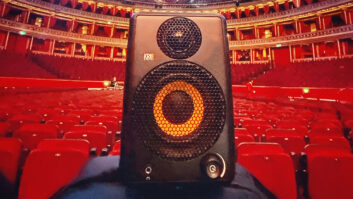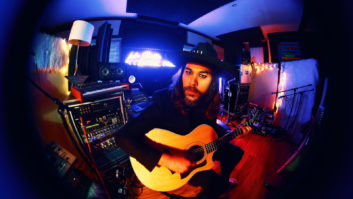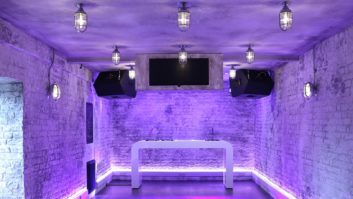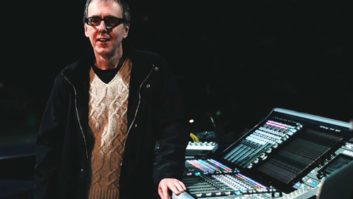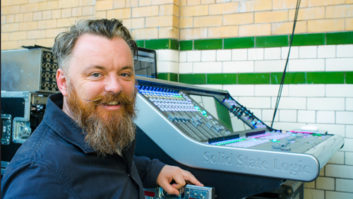RICK SMITH TAKES IT WITH HIMFew bands in recent memory have managed to stay as close to the bleeding edge of trend and technology as London’s Underworld. The band has undergone several complete transformations over its almost 20 years of existence, moving from new wave to neo-industrial, to its current blending of all-things-dance or electronic. Following the release of Dubnobasswithmyheadman in 1993, ’96’s Second Toughest in the Infants and Beaucoup Fish last year, Underworld has emerged as one of the driving forces in electronic music. Much of the acclaim stems from both the band’s captivating live shows and the fact that their sound generally remains well outside dance music’s ever-shifting and emerging genres.
Following the departure this year of renowned DJ/producer Darren Emmerson, Underworld’s current lineup consists of Karl Hyde and Rick Smith. In an effort to forever document the band’s accomplishments over the last eight years, Underworld has opted to do the most unlikely of things for a dance act – they’re releasing a DVD and a live CD, both of which are called Everything, Everything.
Smith was kind enough to take a break from putting the final touches on the new DVD/CD release and work on a new studio album to chat with Mix about the challenges of touring an electronic band, the promises and limitations of 5.1 in a live setting and the future of Underworld.
A live album isn’t the first thing one would expect from you guys. What brought it about?
It was a strange series of events really. Two years ago, Rob Buckely of Strongroom Studios in London gave me some free time to experiment mixing in surround sound. He was a very smart man; I think he knew how excited I would get – you know, the possibilities of throwing sound all around the room. And that stuck with me for about a year. In May of ’99, I was in traffic coming back from the hospital just outside London and something just said to me, “Look, it’s time to document the band’s performances at the moment.” I felt that the medium, the DVD format, just in the simple possibilities of high-quality images and high-quality sound and 6-channel surround, was perfect for coming close to capturing the experience of being at a gig. And really it was the medium of DVD, rather than stereo CD or VHS tape, that cemented it for me. And within about eight days, we had a nine-camera TV crew and mobile recording truck, which Karl and I paid for ourselves.
On a more sort of spiritual level, I had a feeling at the time that we weren’t going to be performing in that way much longer. It was sort of a look in Karl’s eyes that I recognized; we’ve been together for nearly 20 years now. And I just thought, “We’re not going to keep this up like this.” The way we were performing the material where the energy level had risen to a certain point and the pace of things was really fast. And I thought, “This has got a limited life span,” in terms of live performance. As it turns out, with Darren leaving the band earlier this year, I was kind of right in a different way.
If you do choose to go on the road again, are you going to look to incorporate 5.1 in any way?
We did some experiments, funny enough, back in 1993 at Glastonbury with surround sound. It was a thing we did with some guys, Function 1, called the Experimental Soundfield, and it was an enormous success. So this is not something that is new to us in a live sense. But there are real serious difficulties with surround sound live. It can be extremely expensive just because of the laws of nature. If you put a live speaker 25 meters from another one, there is a serious time delay, and it really doesn’t help dance music. So there are issues then about the placement of loudspeakers and the sizes of audiences and the expense that goes with that that are really difficult to overcome. But we’ve been planning on doing something like that for a good couple of years now, but we just really haven’t licked the problem. And it’s a financial one, to be honest. It’s just so expensive that we keep having to rethink our plan. In a general sense then, how do you approach a live situation? It has to be a very different undertaking from say a “regular” rock band.
Well, technically, you’re preparing, essentially, what is an instrument, and the way all this equipment works together and how I get to play it and preparing it so that it is playable and it does translate. Preparing it so that it kind of f – s up fairly often but not too drastically, because the mistakes produce a great response. They can shift directions for you and put you more in touch with something in your subconscious.
There is a simple idea to the system, which I’ve been developing now for ten years, and the principle is still the same. Funny enough, in the past two or three months, myself and Malcolm Colbert, who looks after our equipment and the studio for us, made a bit of a breakthrough, really. The concept was simple really, and that was to be able to jam, to be able to re-interpret electronic music and rhythm, synchronized rhythm and to be free with it. Electronic equipment doesn’t really innately want to do that; it wants to take time to load up, and it wants to go in a particular direction once it’s going there. How can I describe it? I want it to be like a DJ with two record decks with the ability to mix seamlessly between pieces and also be able to move from one thing to another instantaneously. And really, that’s a thread that’s gone through the equipment all this time – in pursuit of that.
There is a master clock [on the system] that says, “Okay, this is going to be this tempo,” and when you press it, everything starts. But the system can be broken down into so many parts that if any one bit screws up, there is another part you just take over and move it in another direction. It also allows you to deconstruct things by turning certain sections on and off. At the end of the day, the most difficult thing for me is there are 56 channels of audio coming off a mixer, and it’s just trying to deal with that physically so that it doesn’t turn into this horrendous noise.
Do you think that more electronic bands are going to start trying to tour in a more traditional sense vs. just doing the DJ thing?
Yeah. I think they will, because record companies want to drive people that way. I think they often have difficulty dealing with the concept of a DJ. But for myself, I think there is no point for a lot of people. I think a great DJ does everything that needs to be done with vinyl; and why bother? It’s a very personal thing; it all comes down to what you want to express.
It seems a lot of the major labels, at least here in the States, keep trying to sell electronic music to the masses like they would anything else.
Yeah, it’s kind of sad, and it’s not just in the States; it’s kind of global. It’s really not the point. Back in 1990, that was really the thing that made me want to find a DJ to work with. My wife’s brother was coming back from these acid-house warehouse parties where 5,000 people would get together in some old factory and some DJs with a couple decks and a P.A., and they were having the time of their lives. And there were Karl and I touring the world with a seven-piece band and all the problems associated with it. It felt like this great lumbering beast that you had to drag all over the place, and we thought, “No, screw this, this is not happening.”
In a sense, those principles are things that we’ve applied to Underworld. We might have this pile of equipment, but Malcolm Corbert, who designs the cases and things the equipment goes in live, and I took great pride in it, kind of being like guerrilla warfare. We can get onstage and within 12 minutes, be ready to play. And that’s important to us.
